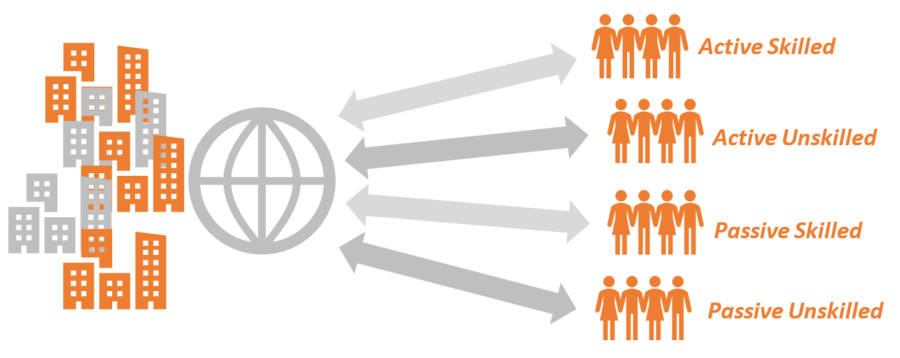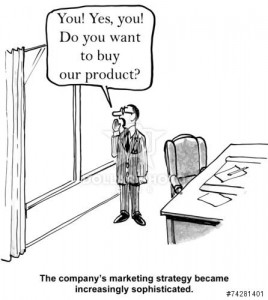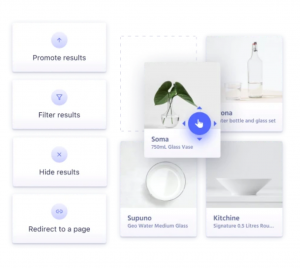— December 6, 2017

iStock
A solid talent pipeline is not just the key to faster hiring; it’s also necessary if you want to hire the talent your organization will need in the future. Unfortunately, 87% of companies struggle to build a talent pipeline. So, what can you do to fix it?
Most companies are failing to build a successful pipeline today because they are building their talent pipelines backwards. Let’s take a look at some research that explains why this is happening, and assess how Recruitment Marketing can help.
Talent in today’s market can be split up into four quadrants:

While over time the definitions of active and passive candidates have largely remained the same, in the wake of the 2008 financial crisis the definitions of skilled and unskilled have changed. Companies today want new hires who can hit the ground running and deliver what they need now. As a result, “skilled workers” are defined as those who fit the skills requirements of a given role without any need for internal training or further certifications.
But the new definition of “skilled” is too narrow. Today, recruiters are focusing on open jobs, or ‘reqs’, as they come in. These reqs are focused on what the company needs today rather than what it will need in the future. This is because hiring is still being driven by the limits of the budget. In today’s c-suite, managing the budget has overwhelmingly become a quarterly priority, shortening the corporate outlook and limiting the amount of risk that management will take on for new ideas, concepts, or directions for the business.
The lack of risk-taking means that the post-2008 crisis c-suite won’t spend money to develop new concepts. While an average of 63% of companies are prioritizing building a more innovative work environment, 75% of them are failing to prioritize the development of new products or services that otherwise create new markets. The corporate instinct has been to blame this on the workforce, but it actually has more to do with how far the c-suite has pushed the responsibility for new initiatives down in the corporate hierarchy. Without the buy-in of the c-suite, managers are only going as far as taking a chance on incremental new developments that differentiate existing products or services without really creating anything new.
The c-suite’s focus on incremental differentiation is putting pressure on talent acquisition leaders to search for candidates with deeper skill sets in hyper-focused areas of today’s product development, not for what will enable the company to compete over the next 5-10 years. The demand for these micro-skill sets is changing faster than the rate at which formal training is changing, creating a perpetual disconnect between skills needed and what exists in the labor market.
Aberdeen looked at job titles over the past 10 years and found that transferability between organizations has reached an all-time low – as an example, a data analyst at one company today requires vastly different skills than a data analyst at another company. Ten years ago, the skill sets needed for this role were more than 50% likely to be transferable to the same role at another firm. Consequently, we’re looking for candidates who match today’s requirements: The problem is that their previous titles and reported skills, by themselves, don’t match where the company is going.
Furthermore, as the volume of available, skilled talent has grown smaller based on the mechanics of post-crisis c-suite risk aversion, members of the active, skilled workforce now have, on average, 4.1 job offers from which to choose. For employers, this means that, for many roles, companies are only able to hire one of the top three candidates they’ve identified for a position less than 50% of the time — increasing our cost and time to hire, while putting companies’ strategies at competitive risk.
How do you, then, build a talent pipeline that aligns with what your organization needs not only today but next year and over the next five years? The answer is in reversing the whole concept of how the job is advertised. When 62% of companies think of recruitment marketing today, they immediately think of their employer brand. But we know recruitment marketing is much more than just building an employer brand. It includes promotion of the brand to the talent market and ongoing monitoring of how that brand is perceived so as to optimize channel promotions and improve the quality of incoming candidates.
Companies that invest in recruitment marketing are able to build top-performing talent pipelines that are candidate-centric, not role-centric. What this means is that companies today need to promote the organization as an ideal place to work and ensure their message reaches the types of applicants they are hoping to attract even before a job is requisitioned. Creating that kind of buzz through outbound recruitment marketing does two things: It puts you in control of the image of your company’s workplace, and it draws applicants from anywhere in the workforce to want to work for your organization.
When candidates get excited about your work environment, they want to enter the company at some point. They become the top of the funnel in the candidate pipeline. Think of the top of the funnel like a conveyor belt of talent. The belt keeps turning as it amasses more and more candidates. Running opposite to the talent conveyor belt is the job requisition belt. The unmatched applicant that creates an emotional connection to the company stays on the talent belt until an opening passes on the job belt that matches his or her application. Once a match is struck, the candidate then progresses into the next phase of the pipeline. From there, it’s up to the hiring team to massage both through to the offer stage.
Recruitment Marketing forms the earliest stage connection with the candidate, helping to set your organization apart from the wider field of options, helping to nurture candidates through the pipeline, and helping to build a database of potential employees that can drive service and innovation today and tomorrow. From there, top performing recruiting organizations are maintaining individualized, personalized communications with identified top candidates more than twice a week. You can support your recruiting teams with recruitment marketing automation and CRM to make this kind of personalized communication scalable.
By helping your organization rebuild talent pipelines to be candidate-centric, you can widen access to your field of candidates in the short term, and be ready to support your organization’s strategy in the long-term. Top performers have increased their reach into the workforce, and the number of available applicants, by recruiting from the active and passive workforces — now at a ratio of 2.5:1. By comparison, all other companies are lagging at 9.7:1. Furthermore, the top performers are most likely to be able to hire one of the top three candidates identified for a role. What odds do you want for recruiting top talent?
This post was co-authored by Lori Sylvia
Business & Finance Articles on Business 2 Community
(90)







